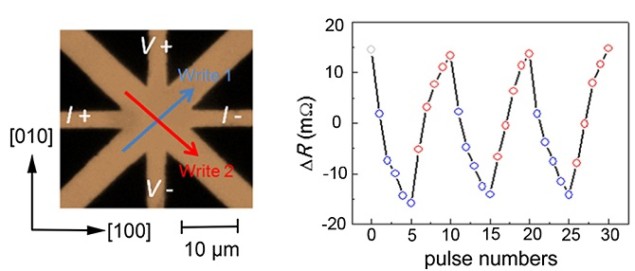
Antiferromagnetic materials have a lot going for them for high-density fast-operating memory applications. As Tsinghua University researcher Song Cheng points out they have no net magnetic moment, exhibit ultrafast spin dynamics with characteristic frequencies in the terahertz range, produce negligible stray fields, and they are robust against magnetic perturbations. Now Song and colleagues in China and the US have reported a previously unobserved switching mechanism in NiO on platinum that could broaden opportunities for exploiting antiferromagnetic switching for data storage.
Switching the Néel order
In an antiferromagnetic material the magnetic moments of neighbouring atoms – determined by the electron spins – are aligned antiparallel to each other, an arrangement described as Néel order. To use this antiferromagnetic order in memory applications some way of manipulating it is crucial, and one option is using spin-transfer effects that arise on applying a current to the material.
In fact Peter Wadley and Bryn Howells at Nottingham University in the UK alongside a group of researchers across Europe previously reported antiferromagnetic switching in CuMnAs in response to a current. Here the current gave rise to a spin-orbit torque, switching the spin polarizations in the sublattices of the crystal. While the work signified an important step forward for antiferromagnetic memory applications, the mechanism of the switching – known as the Edelstein effect – is only possible for a very limited range of materials where the crystalline structure has specific symmetries.
A switch for all crystal structures
Instead Song and colleagues made use of an “antidamping” spin-orbit torque to switch the antiferromagnetism. “In this work, spin currents, generated from the spin Hall effect in the heavy metal (i.e., platinum), are used to trigger the antiferromagnetic moment oscillation and to switch the adjacent Néel order of the antiferromagnet at room temperature,” Song explains.
Although there have been previous proposals of an “antidamping torque” that could switch the antiferromagnetic order in these kinds of structures regardless of crystal symmetry, until now there had been no observations of it. Song and colleagues’ studies focused on the (001) crystal plane of NiO on platinum, and they were able to observe switching in the direction of the current from measurements of the spin Hall magnetoresistance of the material.
The antidamping torque switching is highly reversible and could be used to write 0s and 1s for digital memory. “This finding could be readily generalized to ubiquitous biaxial antiferromagnets, providing broad opportunities for all-electrical writing and readout in antiferromagnetic spintronics,” adds Song.
Full details are reported in Physical Review Letters



